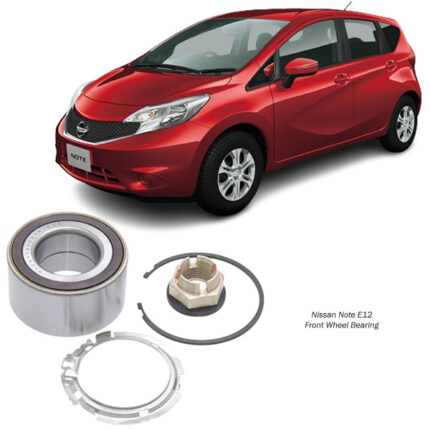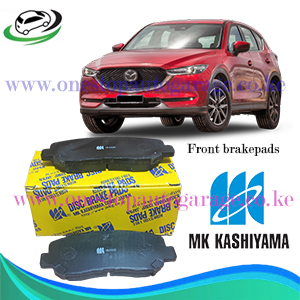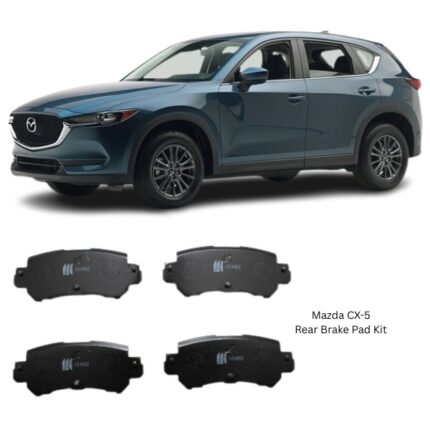Get Mazda CX-5 Rear Brake Pad Kit D3156 in Kenya
The Rear Brake Pad Kit is an essential component of a vehicle’s rear braking system, designed to deliver reliable stopping power, consistent performance, and safe operation under a wide range of driving conditions. As part of the disc braking mechanism, rear brake pads convert kinetic energy into thermal energy through friction, enabling the vehicle to decelerate or stop smoothly and effectively.
Each kit includes a set of precision-engineered brake pads for both rear wheels. The pads are manufactured using advanced friction materials that ensure balanced performance, low noise output, minimal dust generation, and extended lifespan. These components are essential to maintaining safe braking, stable handling, and predictable stopping distances.
Function of Rear Brake Pads
Rear brake pads play a pivotal role in braking dynamics by:
-
Creating Friction: When the brake pedal is pressed, hydraulic pressure pushes the rear caliper pistons against the brake pads, forcing them to clamp onto the brake rotor. This friction generates heat and slows the rotation of the rear wheels.
-
Distributing Braking Load: While front brakes perform the majority of braking, rear brake pads contribute to vehicle balance, especially during deceleration, hill starts, and emergency stops.
-
Stabilizing Vehicle Movement: The rear brakes assist in reducing nose dive during hard braking and help maintain traction and control, particularly under heavy loads or slippery conditions.
-
Parking Brake Integration: In many vehicles, the rear pads also interact with the handbrake or electronic parking brake system, providing secure parking stability.
Components Included in the Kit
A standard rear brake pad kit comprises:
-
Four Brake Pads: Two for each side of the rear axle. Each pad includes a friction lining bonded or riveted to a steel backing plate.
-
Anti-Rattle Clips or Shims: These components reduce vibrations and noise, improving brake pad stability within the caliper.
-
Wear Indicators (Where Applicable): Either mechanical or electronic, to signal when the brake pads have worn down to a predefined limit.
-
Lubrication Pack (Optional): A small packet of high-temperature brake grease for use on contact points to minimize noise and ensure smooth pad movement.
Materials and Construction
Rear brake pads are crafted using a range of friction materials depending on performance requirements, driving conditions, and environmental considerations. Common types include:
-
Semi-Metallic Pads: Contain 30–60% metal such as steel, copper, or iron. They provide strong stopping power, good heat dissipation, and durability under extreme conditions.
-
Non-Asbestos Organic (NAO) Pads: Composed of organic fibers, fillers, and binders. Known for quiet operation and softer engagement, though with reduced lifespan under heavy loads.
-
Low-Metallic NAO Pads: Blend organic materials with small amounts of metal to enhance braking strength while maintaining quiet performance.
-
Ceramic Pads: Utilize ceramic fibers and non-ferrous filler materials. They offer excellent heat resistance, low dust levels, and long wear life with minimal fade.
The backing plate is typically made from hardened steel to provide structural support, resist corrosion, and ensure even pad pressure across the rotor surface.
Key Features and Benefits
A high-quality Rear Brake Pad Kit delivers:
-
Reliable Stopping Performance: Maintains consistent braking force under varied temperature and speed conditions.
-
Low Dust Formulation: Reduces wheel soiling and extends the life of surrounding components.
-
Quiet Operation: Precision chamfers, slots, and shims minimize vibration and eliminate squealing.
-
Fade Resistance: Advanced friction materials withstand heat build-up, reducing the risk of performance loss over long descents or repeated stops.
-
Long Service Life: Optimized wear characteristics ensure longevity without compromising braking strength.
-
Easy Installation: Designed to fit within standard caliper assemblies with minimal modification or adjustment.
-
Thermal Stability: Materials retain performance integrity even under high-stress braking scenarios.
-
Even Pad Wear: Engineered to distribute pressure evenly, reducing uneven wear patterns and extending rotor life.
Signs of Rear Brake Pad Wear
Routine inspections of rear brake pads are crucial for maintaining safety and performance. Common indicators of worn pads include:
-
Grinding or Squealing Noises: A metallic sound when braking suggests pads are worn down to the backing plate.
-
Reduced Braking Power: Longer stopping distances or spongy pedal feel may signal degraded rear pad performance.
-
Vibration Under Braking: Uneven pad wear or glaze buildup can cause pulsations in the brake pedal.
-
Brake Warning Light: In vehicles with electronic wear sensors, a dashboard light may indicate when pads need replacement.
-
Visual Inspection: Pads less than 3mm thick should be replaced promptly to avoid rotor damage.
Ignoring these signs may lead to compromised braking ability, increased stopping distances, or more costly repairs due to rotor scoring or caliper failure.
Installation Notes
Replacing rear brake pads is a moderately straightforward task, although it may require specialized tools in vehicles with electronic parking brakes. Key steps include:
-
Raise and Secure the Vehicle: Use appropriate jack stands to lift and stabilize the rear axle.
-
Remove the Rear Wheels: Access the caliper assembly by removing the wheels.
-
Retract the Caliper Pistons: Necessary to accommodate the thickness of the new pads.
-
Remove Old Pads and Hardware: Clean the caliper bracket and inspect for wear or damage.
-
Install New Pads and Accessories: Apply brake grease to contact points, insert shims or clips, and mount the new pads.
-
Reinstall Caliper and Wheels: Torque bolts to specification and verify component fitment.
-
Test the Brakes: After installation, depress the brake pedal several times to seat the pads against the rotors before driving.
A post-installation road test is recommended to ensure proper brake engagement and absence of abnormal sounds.
Maintenance and Longevity
Rear brake pads typically last between 40,000 to 80,000 kilometers, depending on:
-
Driving Style: Aggressive braking shortens pad life.
-
Vehicle Load: Heavier loads increase wear.
-
Terrain: Hilly or mountainous regions put more stress on the rear brakes.
-
Environmental Factors: Exposure to dirt, salt, or moisture can lead to faster degradation.
It’s advisable to inspect the rear brake system during every oil change or tire rotation to catch early signs of wear.
Environmental Considerations
Modern brake pad formulations aim to minimize environmental impact by reducing or eliminating harmful materials like copper or asbestos. Eco-friendly pad designs not only protect the environment but also deliver consistent performance with fewer harmful emissions and less brake dust.
Follow us on Facebook for more parts.




